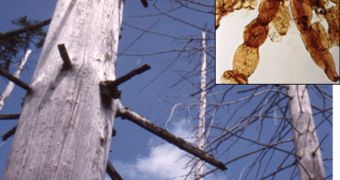Some 251.4 million years ago, a cataclysm destroyed most living things on our planet, including microorganisms, plants, and higher animals. Informally known as The Great Dying, the Permian–Triassic (P–Tr) extinction event was the most severe battering the Earth had ever faced during its five cataclysmic extinctions. Now, new research suggests that this post-apocalyptic world provided some fungi with the most appropriate conditions to multiply and spread throughout the globe, feasting on what remained after the nature took its course, ScienceNow reports.
Reduviasporonites is a genus of microorganisms that was first tested in 1996. At the time, experts established that they were fungi, but subsequent investigations hinted that they might be a form of algae. It was only recently that members of an international team settled this debate, when they concluded that the organism, which is commonly found in the P-Tr boundary layer, was a fungus. Additionally, the panel's research also brought up an interesting fact – the fungus' diet mainly consisted of dead trees. Planetary scientists say that this bit of information may lead them to determine the exact cause of the Third Extinction, for which one is still elusive.
When looking at the chemical footprint of Reduviasporonites, the researchers paid a special attention to carbon and nitrogen isotopes. Given that the microorganism dominated the landscape between the Permian and Triassic periods, experts say, it stands to reason that the fungus was spread throughout the globe. This was proven beyond doubt when researchers identified traces of the compounds and of the microorganism at several locations around the world. They explain that, back then, only one continent existed on the planet, Pangaea, and that spreading globally was not as difficult as it is today.
Imperial College London astrobiologist Mark Sephton has been the leader of the new research, and also the author of a new paper detailing the finds, published in the October 1st issue of the respected scientific journal Geology. He argues that the environment may have changed so dramatically over a short period of time on account of a massive release of sulfur dioxide and other noxious gases, most probably from volcanic eruptions. These gases would have then formed acid rain that killed the trees and allowed Reduviasporonites to spread like crazy.

 14 DAY TRIAL //
14 DAY TRIAL //